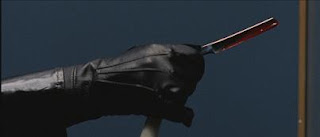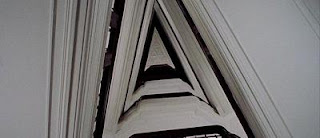
Sam Dalmas, an American trying to solve his writer's block with a holiday in Rome, sees two figures struggling over a knife in an art gallery - one a woman, the other dressed in black plastic raincoat, black leather gloves and black hat. He rushes to help but becomes trapped between two sets of glass doors, unable to get into the gallery or back out to the street. He watches helplessly as the figure in black flees and the woman, having been stabbed in the stomach, crawls across the floor in agony.

The woman survives, and when the police question Sam he is certain that he's seen a crucial clue but he can't quite remember what it is. When the police take away his passport to retain him as a witness, believing the attack to be only the latest in a series of attacks by a serial killer, he decides that he really needs to solve the murders himself.
Something that tends to strike people who see this movie after a number of Argento's later works is how tightly plotted it is. His later movies - especially from Suspiria onwards - often feature stories that are either impossibly convoluted (e.g. Tenebre) or downright nonsensical (particularly Phenomena). But at this stage of his career Argento regarded himself as a writer rather than as a director, and apparently only insisted on directing this one because he was sick of seeing other directors ruin his scripts. (One hopes he was at least satisfied with Sergio Leone's handling of Once Upon a Time in the West, which he co-wrote with Bernardo Bertolucci).
Given this, while I've always been quite cavalier about throwing around blatant spoilers on this blog, The Bird with the Crystal Plumage is a pretty great murder mystery and if you haven't seen it you really should go out and rent it, then come back here and read the rest of this. It's now easily available on DVD in most territories, so you shouldn't have any trouble finding it.
If you've seen the movie, or don't give a damn if I ruin the ending, then read on. I'll be talking about the identity of the killer before I reach the end of the synopsis, so don't say I didn't warn you. Now let's go on...
The Bird with the Crystal Plumage was one of the most crucial movies in that very particular Italian subgenre known as the giallo. Named for the colour of mystery paperback covers, a giallo started off just as an Italian murder mystery in which a good percentage of the characters are offed by a killer, usually motivated by greed. The great horror director Mario Bava is usually credited with the first giallo movies, The Girl Who Knew Too Much and Blood and Black Lace, and the latter film in particular was a huge influence of Argento's first movie; Blood and Black Lace's killer dresses almost identically to the one in Bird. But neither of Bava's movies was an international hit on the scale that Bird was to become, and so it was the latter movie that really established this as the costume of the giallo villain.

Argento's penchant for playing the gloved hands of the killer also started with this movie. This is one of the elements that earned him the reputation for being a misogynist, but it's more complicated than that. It's true that Argento identifies with his killers, and it's also true that many of the murders in his movies are highly sexualised and that the victims are usually beautiful women. Quotes like this one don't help either:
"I like women, especially beautiful ones. If they have a good face and figure, I would much prefer to watch them being murdered than an ugly woman or a man."

Which compares interestingly with this famous quote from Edgar Allan Poe:
"The death of a beautiful woman is, unquestionably, the most poetical topic in the world."

I would argue that the key part of Argento's quote is right at the start. Any kind of careful viewing of his movies shows that he really loves women. I'll get more into this as we go through his filmography, especially one we get into the movies with female protagonists, but straight away in this one we have the simple example that Argento identifies very strongly with the killer - who turns out to be a woman. In fact, the killer turns out to be the victim from that key scene in the art gallery; the clue that Sam has missed is that the man in the raincoat was not attacking, but was in fact defending himself. The man was the killer's husband, who ends up confessing to the killings in order to protect his wife.
The real identity of the killer is revealed in a surprise ending. Unlike the gratuitous twists that modern filmgoers are used to, this one is actually the most important part of the story, and rewatching the movie knowing the ending is actually a lot of fun. Argento doesn't cheat the viewer; all the clues are there throughout.
One key image in this movie is a painting of a woman being brutally attacked. This painting depicts a long-suppressed trauma in the killer's life, and when she sees it she is tipped over into psychosis. As the movie's postscript (which amusingly, and slightly mockingly, pays homage to Psycho) explains, seeing the painting has somehow shifted her self-identification away from being the victim into being the attacker, compelling her to repeatedly re-enact her own attack from the other side.

There's an odd sequence in this movie where a completely different killer shows up, played by the scary-looking Reggie Nalder. This killer uses a gun, and turns out to be a hitman hired by the main killer to eliminate Sam. I don't recall ever seeing another movie where a serial killer hires a hitman. Dealing with a serial killer turns out to be a bad idea, as Nalder later turns up dead himself.

Although Argento had never directed before, nothing about The Bird with the Crystal Plumage demonstrates any neophyte clumsiness. This might simply be down to the fact that he is surrounded by first-rate craftspeople; the cinematographer is Vittorio Storaro (Apocalypse Now, 1900), the music is by Ennio Morricone (who had already composed over a hundred scores, including all of Sergio Leone's westerns, and would go on to compose over three hundred more), etc. He had also grown up with the movies, as his father was a producer and his mother an actor, and before becoming a scriptwriter he was a film critic.
In any case, I'm sure that we can ascribe the beautiful look of the movie to Vittorio Storaro. Anyone who has only ever seen this movie on VHS really needs to check out the DVD as soon as possible.




No comments:
Post a Comment